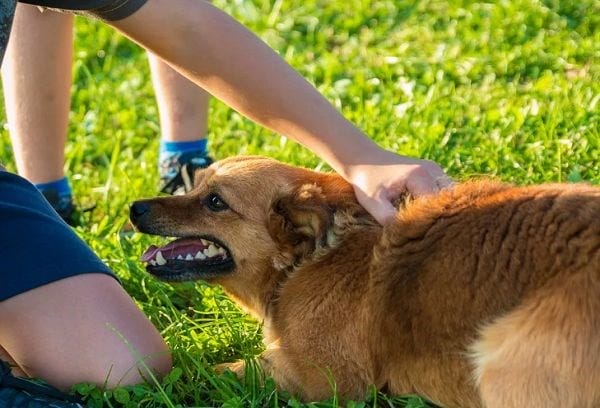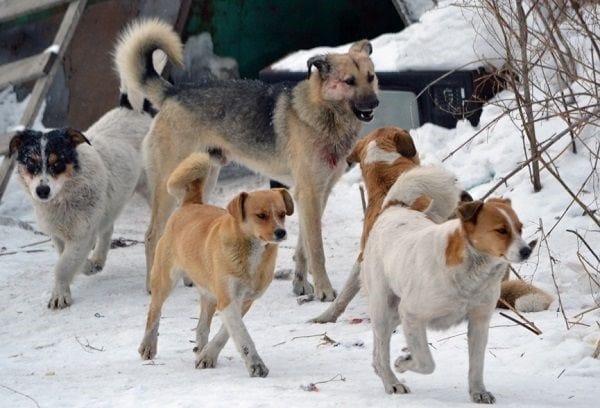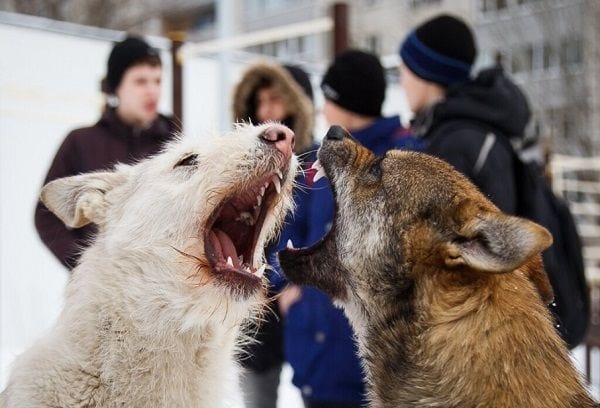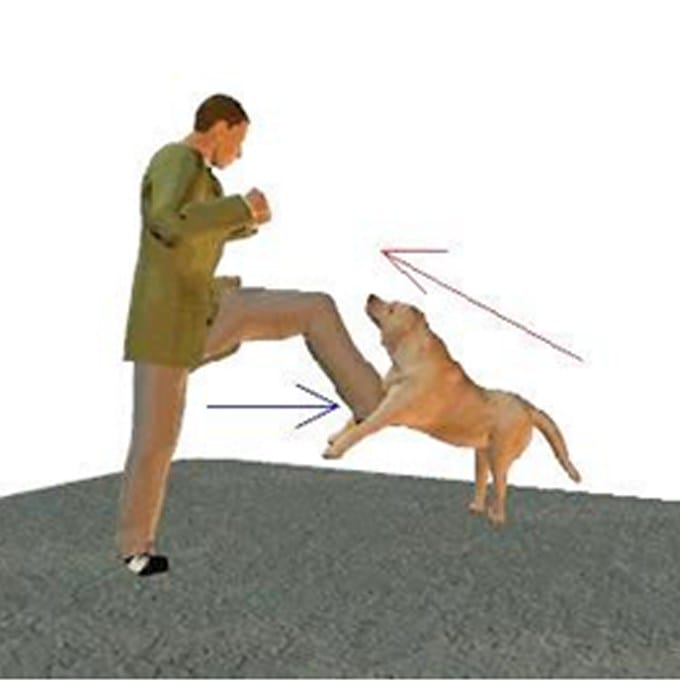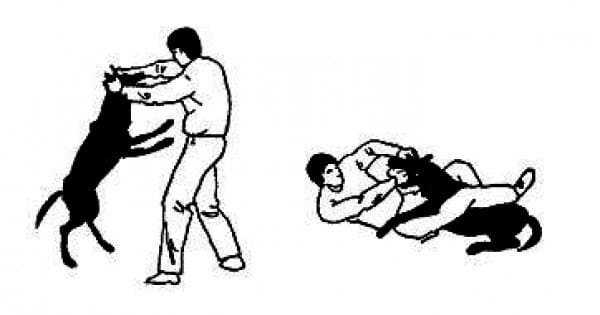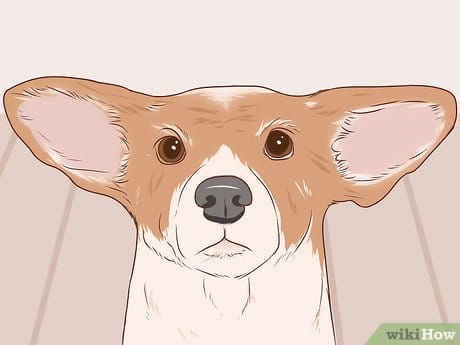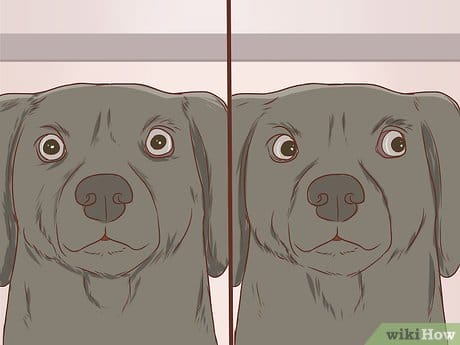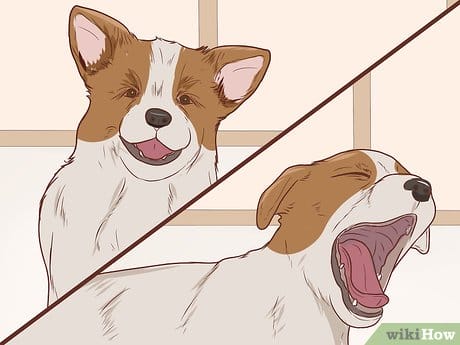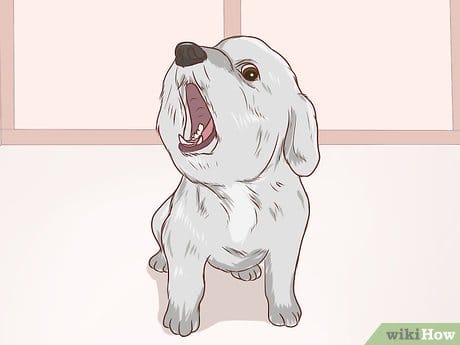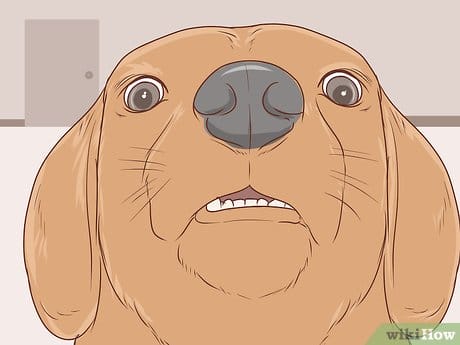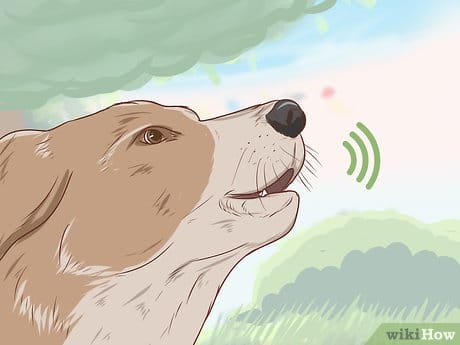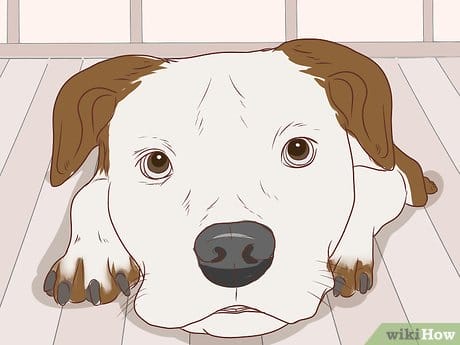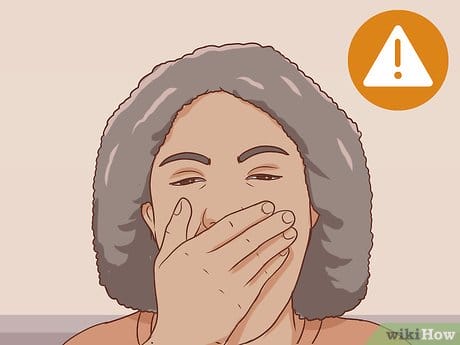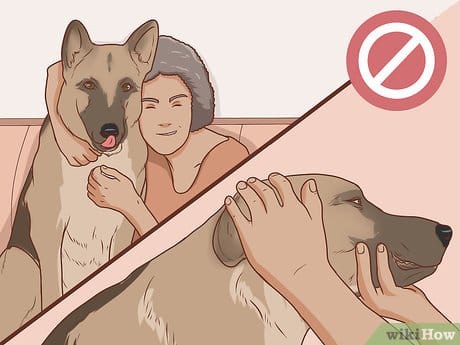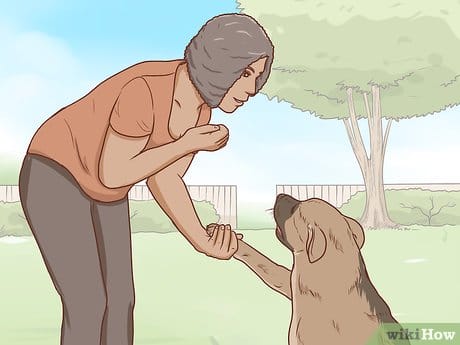What not to do
Everyone who is not familiar with the psychology of stray dogs wants to perform these actions. Remember for yourself and tell the children what not to do when the flock attacks:
- turn your back;
- swing your arms;
- shout;
- run away;
- gaze into the eyes of dogs;
- touch animals, grab the tail.
If along the way you spot stray dogs, do not behave defiantly, do not provoke animals. Better to get around this area – the dogs will defend their territory. This explains the situations when the animal follows you with barking to a certain place, and then calmly turns around and leaves.
What to do if surrounded by a flock
The rules of self-defense are the same both when attacking one dog and in packs. If a pack of dogs attacks, try to calm down. These animals intuitively feel the fear of the victim. Your behavior and even the smell of your sweat will instantly betray you.
Correct actions when attacking dogs:
- Don’t show your fear, make it clear that you are not afraid.
- Look around calmly, take a stone or a stick, but without sudden movements. Let the dog think about whether to contact an armed man.
- Don’t be surrounded by the flock, move slowly.
- If the interest of the animals does not fade away, turn right to them and try to say “Fu!”, “Back!” In a strict, loud and confident voice. or “Stop!”
- Carry a can of pepper with you. Any aerosol, water will also come in handy.
- A very useful item for such situations is the stun gun.
When the dogs’ confidence decreases (stop growling, sit down), start slowly moving away without looking back.
Assess the situation in advance: if the dog is a stray, unkempt, then there is a high probability that he is infected with rabies. It will be difficult to get rid of such a dog.
Signs of aggression
A raised withers, alert ears and tail are the first signs that a dog is alarmed. An impending attack may be indicated by a nervous twitching of the tail, a bristling back and tension in the paws, as if the animal is about to make a sharp dash. Growling and barking are also clear signs of aggression. However, a dog that has not uttered a sound can also bite.
The most dangerous encounter is with a pack of stray dogs. They are more aggressive and less afraid of people. Dogs, about to attack, usually begin to surround a person in a ring. In this case, you need to look not for escape routes, but for a wall or tree against which you can rest your back so that the dogs do not knock you down.
How can an attack be prevented?
The main rule – do not try to run away from a pack of aggressive mongrels – a dog is 5 times faster than a person. The animals will perceive the running figure as prey and will swoop down from behind. To prevent an attack, it is best to keep moving calmly in your direction.
If you can’t ignore the dog, the first thing to remember is if you have anything edible with you. Perhaps the animals were attracted by the smell of sausage – it is better to part with the supplies for your own safety.
When the distance between a person and a dog is more than 10 meters, you can pull the animal with a firm voice, raise a stick, a stone or throw a handful of earth. Stray dogs are usually afraid of rocks, clods of earth and are more likely to run away, experts say. The dogs may continue to chase for a while, so the rock trick may need to be repeated several times. It is important not to panic and keep moving until the pack territory ends.
When the animal is already at a distance of less than 5 meters, in no case bend over – this will only give the dog the opportunity to attack. It is better to move to any support that, in the event of an attack, will help not to fall.
If you constantly have to walk to places where many stray dogs live, you should purchase protective equipment in advance: ultrasound, a stun gun, pepper spray, or just a firecracker. They can scare animals away, but they don’t always work.
Where to go when bitten?
If you are bitten by a stray dog, you need to wash the wound yourself with water and soap and consult a doctor as soon as possible.
The animal can be infected with rabies, in this case, without timely vaccination, the bitten one is in danger of death. If an examination can be ordered when a domestic dog is bitten, then a stray, most likely, will not be able to catch, so the doctor in any case should prescribe injections. If earlier 40 injections were made to completely exclude the disease, now only six are enough. They are made according to a certain scheme for 90 days.
Cases of attacks by dogs on a person must also be reported to specialized services. In Moscow and the Moscow region there is a service for catching wild animals of the State Unitary Enterprise “SOJ”, a round-the-clock telephone – +7 (495) 781-00-08. The organization accepts applications for trapping and neutering dogs, including aggressive ones.
A fauna specialist must submit an application, therefore, a written application to the Criminal Code or HOA from residents of the house near which stray animals live will be required.
How to tell if a dog is about to attack
If bitten by a dog: what to do according to the law
Before pouncing, the animal shows signs of aggression, which you should also know and be able to analyze. Alert ears, a tense tail and a raised withers are the main indicators. Nervous and incessant twitching of the tail, tense paws and bristling back predominantly indicate that the animal is preparing to break off and bite.
Note! Barking and growling are also signs of an aggressive attitude towards a person, however, an absolutely quiet dog can cause damage.
A man’s attempt to stab a dog when attacking will not lead to anything good.
The greatest danger to humans is represented by flocks of stray animals. They are practically not afraid of people and, due to the difficult conditions of survival, are aggressive. Flocks, as a rule, try to create a ring around a person. In this case, you just need to rest your back against a wall or tree so that the animals are not knocked down.
Important! In order not to accidentally meet a pack or a lonely stray dog, or rather to reduce the likelihood of an attack, it is better to walk along busy and lighted streets.
What absolutely should not be done
There is a fairly extensive list of what to do if a dog is attacked.
A way to disorient an animal
For self-defense purposes, every person should familiarize themselves with it:
- make attempts to find a common language with the animal. Agreeing with him will definitely not work. On the contrary, it is necessary to avoid all direct contacts;
- if a person has decided to throw any object at the dog, then it is not necessary to do this purposefully in the mouth. The essence of protection is that the dog pounces on the object itself, and this is precious time during which a person can hide;
- you cannot shout at an animal or throw stones at it, this will only increase aggression. If possible, it is recommended to throw something over the eyes of the animal, it is disorienting.
Important! If a person understands that there is no other way out and will have to take a fight, you need to be as aggressive as possible. It is possible that the dog will be confused or scared, from which it will retreat.
Tips from dog handlers and EMERCOM employees
Cynologists and experienced dog breeders have compiled a set of rules and recommendations on what to do when a dog attacks a person:
- when an animal barks loudly, it usually shows that she does not want to attack, but simply scares and wants to drive the person out of her place. You need to remain calm and in no case turn your back to the animal, it can chase and bite. It is necessary to retreat with your back forward carefully and without sudden movements;
- if a person feels the strength in himself, then it is strongly recommended to strike first, perhaps when the dog is already in the jump. The painful sensations will definitely disorient the animal;
- if the danger is high, and there is a large grinning dog in front, then you need to try to lean your back against a hard surface in order to deprive it of the opportunity to knock a person down, and also to fully control the situation.
Personal protective equipment against dogs
In a fight with an animal, it is a big mistake to conduct a passive defense, so the person will definitely suffer more. You need to be as aggressive as possible.
If a dog attacks
Dogs are different. Even within the same breed, the character of the dog can differ.
Situations are different. Males chasing a bitch in heat do not behave like a bitch defending puppies. And a trained alabai, in whose yard you accidentally entered, will work in a completely different way.
None of the tips below are dogmatic. It may work, or it may not. The task of self-defense is to minimize damage, increase the chances of success Only Gosstrakh gives a 100% guarantee.
We will not consider the case of launching a trained service dog on you by an inadequate owner – not because this cannot be (inadequate enough), but because in this case you have very few chances, and theoretical knowledge without practical skills will not help you.
Let’s stop at the mongrels.
Why is the dog barking at you? A million reasons. She’s scared. She is bored. She is currying favor with the pack. Protects the territory, bitch, offspring.
First, let’s figure out what should not be done in any case.
- You can’t run. The smallest mongrel runs faster than a person. He ran – he will chase.
- You can’t turn your back. A dog, if not trained, never attacks in the face.
- You can’t squat. If you are smaller, you are less scary. The higher the chances that he will rush.
- You cannot pretend that you pick up a stone and throw it. It can work, or it can provoke aggression and a call for help from the whole flock.
- You can’t kick the dog with your foot – you won’t hit, this is one, if you hit the leg – that’s two. Waving your arms is also not worth it. Zero sense, and the groin was opened.
Also, do not try to punch the dog in the nose (you won’t hit it), thrust your fist into its throat (God, who comes up with these tips ?!) and catch it by the groin fold (seriously, these are recommendations from the Internet). Wrapping the jacket around the forearm will also do little for an ankle bite.
Why stray dogs attack
Main reasons:
- Annoying human actions, fright. Perhaps the dog did not notice the person while he was approaching, or it is annoyed by the flashing of legs while running, the glare of bicycle spokes, loud rustling sounds, violent gestures, the smell of alcohol.
- Protection of the territory of rest and feeding. Despite the fact that each stray dog or pack has a rather large “zone of influence”, they fiercely defend a small area where they are regularly fed or where a rookery for dogs with puppies is arranged.
- Boredom. The dog has decided that you are a suitable subject for play or hunting.
- The dog has rabies, and you are unlucky enough to be around.
When passing by any unfamiliar dog, try to pretend that you did not pay attention to it. If possible, deviate slightly from the intended path in order to get around the dog for at least 2-3 meters. Keep it in sight, but do not look into the eyes (this will be regarded as aggression, try to somehow look into the eyes of the tied dog), do not speed up, do not turn around, do not try to talk to the dog or get its attention in any other way. Exception: if you walk by, but she does not see you. Then it will not be superfluous to cough, for example, so as not to accidentally scare the dog, being in close proximity. The dog must understand that you are not interested in it. You are not claiming its territory or food.
If the dog growls, rears its withers and moves sideways in your direction, or starts barking, first, estimate the distance. If the dog is a good 10 meters from you, it approaches rather slowly, most likely, it is more frightened than you. Better to keep pretending not to pay attention to her. Go where you went! Do not accelerate, but walk away with a confident step.
You can pretend that you are picking up a stick, a stone, or actually picking something up. Stray dogs usually have an unpleasant experience with these items and are more likely to choose to retire.
If the distance between you is less than 5 meters, you cannot lift something from the ground! Leaning over the object gives your dog the perfect opportunity to grab onto your neck immediately. To begin with, try to pull her back in a firm low voice, say: “Get out! Fu! “. Pretend that you already have something in your hand and that you are ready to take advantage of it.
If the dog is set up quite decisively, barks deafeningly, does not stop, or behaves as if it is playing with you: it runs up, bites lightly on the leg, the floor of its outerwear, runs back, jumps up and runs up again – there is a great chance of an attack. If shouts and threats did not help, stop, take a step towards, throw a lump of earth, a stone, a stick at the dog. If the dog stops or retreats, do not chase.
This is especially important if you are faced with a pack. While you are following the most impudent dog, the others will attack from behind you. Wait 5-10 seconds and continue on the original route. So you make it clear that if she does not touch you, you will not touch her. Everyone still has a chance to disperse without loss. The dog may continue to chase when you turn away. Do not panic, shout at her again, wave your bag, hat – whatever. Throw another stone. You may have to repeat these actions several times, but it will be over pretty soon: the radius of the protected area of the dog is small, it is unlikely that it will chase you for more than 20 meters.
I hope you never need this, but the next paragraph should be felt right now while you are safe. If a dog runs at you with its tail raised and barking deafeningly, not responding to your threats, or after all your manipulations it still tries to bite or knock you down, the time for diplomacy has passed. That’s it, civilization is over. You are not wearing an uncomfortable mini-skirt that will pull up ridiculously, there is no expensive suit, there is nothing in your bag that is more important than your life. The interview you go to trying to look presentable may never happen unless you get a killing caveman from the depths of your mind right now.
Drop your disgust. You should now be ready to break bones, break your necks, scream in your stomach, look threatening, and do scary things. You are in grave danger.
How to defend
Of course, even if you walk through a wasteland with a pack of dogs every day on your way to work, you probably won’t want to carry a baseball bat with you. You can limit yourself to the items you need in your daily life, but keep them strong enough to serve you in case of danger. And it is very important that these items can be reached with one easy movement.
- The hairbrush is metal, with a long thin handle.
- Ballpoint pen with metal body.
- Long keys to the garage or front door.
- Umbrella. It is better to use it open as a shield, covering vulnerable parts of the body or frightening the dog by suddenly opening it in front of the muzzle.
- Package. Psychological attack: the bag filled with air looks intimidating to the dog. You can also suffocate with a bag.
- Lighter. With the gas turned to the maximum, it can give a good burst of flame for a few seconds.
- Coins for weighting the blow. If you have only fists in your asset, at least make them more effective. You can also throw coins in the dog’s face if you really have a lot of little things.
- Stiletto heels (yes, I also feel sorry for your stilettos in advance, but without them you will be more stable, and getting a thin strong heel in the face of an attacking dog is priceless).
- Objects that you can find around you on the ground: snowballs, large stones, sticks (throw at the dog if there are a lot of stones; use to inflict crippling blows, if there is only one stone), sand, earth, small stones (throw in the dog’s face, trying get in the eyes, nose or mouth).
It is good if you have real means of self-defense, but not always what serves you to protect yourself from a person is suitable for a dog. For example, nerve gas will have no effect on her. A can of pepper or mustard can be much more effective if you manage to discharge it in the path of the dog so that it gets into the cloud of gas before it is blown away by the wind. The stun gun can be discharged into the air to scare the dog with the crackling sound and smell of ozone. For large dogs with thick hair and undercoat, direct electrical discharge may be useless.
How to defend yourself
Surely everyone from childhood was told that dogs feel fear and bite only those who are afraid of them. However, fear is not the only emotion a dog understands. If instead of being scared, you portray joy, it can be very confusing for the aggressive dog. Behave outside the box.
If a dog attacks you, cover your vulnerable parts of the body: tilt your head, covering your throat with your chin, put a bag in front of you, a hand wrapped in a scarf or a sleeve of outerwear, a stick (whatever!) And go to meet her with a joyful cry: “Well, finally- then! Now I’ll give you something! ” (I leave the choice of words on your conscience, but your scream should be loud, at the same time you will attract the attention of people around). If you have learned to enter the state of a wild man, it will not be difficult for you to rejoice at the opportunity to eat fresh dog meat. Try not to get angry. Your anger will be interpreted as fear. All you have to radiate is the confidence of a winner.
Remember that a dog’s main weapon is its teeth and weight. She will not claw you with her claws. Typical behavior of a dog when attacking is jumping, knocking the opponent down and subsequent bites. When jumping, try to dodge, this will reduce the dog’s confidence in their abilities. If you have a bag, hat, outerwear in your hands, put it in front of you. If there is nothing, put your palm forward. A bitten hand is the lesser of evils. The dog attacks this very object and hangs on it. Never let go! Pull yourself!
While the dog is trying to snatch the shield from you or break it with its fangs, hit it on vulnerable parts of the body: the tip of the nose, the bridge of the nose, eyes, the back of the head, the place behind the ears, solar plexus, genitals, coccyx, paws. Do not slap in these places, hoping that the dog will be scared. Everything that you can reach should be hit as painfully as possible; everything that falls into your hands needs to be broken. If you have enough strength to knock the dog down, bring down and sharply fall on it with your knee, breaking the ribs. Remember: your only ambition right now should be to destroy the enemy.
If there are several dogs, try not to be surrounded. Use every opportunity to leave the territory guarded by the pack, but in no case run.
Advice directly on the fight is relevant for both stray and domestic dogs, for the rest, for domestic dogs, an amendment must be made: to scare a domestic dog, if it is next to the owner, you will not succeed, skip this item right away. If the owner is in no hurry to drag his pet away from you, you need to try to retreat to a place where the dog will not see him. The desire to attack you without eye contact with the owner is sharply reduced in the dog.
Any damage to the skin caused by a dog must be thoroughly washed with soap and water and fixed in an emergency room. A dog with inappropriate, atypical behavior may have rabies. Infection can be transmitted when an infectious material, usually saliva, comes into direct contact with mucous membranes or fresh wounds on a person’s skin. Rabies is incurable and requires early vaccination. The good news: this is no longer “40 injections in the stomach”, but only six in the shoulder, performed according to a specific pattern for 90 days. If you can observe an animal that has bitten you and does not show signs of rabies for 10 days, vaccination can be interrupted.
What methods cannot be used in raising an adult dog
By adhering to such prohibitions, you will give your four-legged friend a great start into a new, adult life. However, those who think that the prohibitions and restrictions will decrease with age are mistaken.
Growing up, the pet regularly tries to reconsider its own place on the hierarchical ladder of its own pack. In order to prevent riots on the ship and to properly respond to the undesirable behavior of the animal, it is necessary that the contact between you is as strong as possible.
And this cannot be achieved without the correct behavior:
- When punishing your dog, do it right. The owner’s arms and legs, as well as the harness for walking, should be associated with the dog only with positive emotions. Therefore, it is unacceptable to severely beat the dog or whip it with a leash.
- Another common misconception common among most inexperienced dog owners is the punishment of a pet who escaped, finally deciding to come up on command. Experienced trainers recommend using physical pressure only if you yourself have caught up with the fleeing dog. A pet that comes up on its own, even with 10 or even 20 beckons, needs to be reluctantly praised and encouraged with some kind of delicacy. A slap in the hearts will lead to the fact that the pet, remembering the punishment, will never again react to the command “to me”.
- The main tenet of training is the statement that any dog should unconditionally allow the owner to take food from him. The absence of aggression at this moment in the animal speaks of the highest degree of trust and submission to a person. However, you should not abuse such a demonstration of your power. Regular food intake is not conducive to the development of trust between the owner and the pet, and is not genetically determined by the canine’s behavioral matrices.
- In no case should you use tools to develop obedience that allow you to manipulate animals – strict and electroshock collars, shockers or strangleholds. Such actions performed by an amateur are especially dangerous. The risk of causing injury or death to your pet is unusually high. Agree, no obedience is worth your life.
- Training methods designed to increase the degree of aggression can only be carried out under the guidance of an experienced dog handler and not for all breeds of dogs. Otherwise, you will simply turn an adequate dog into an evil, poisoned creature that enjoys evil demarches.
Interpretation of facial expressions and head movements
-
![Do's and don'ts when dogs are attacked: a rulebook. If a dog attacks - what to do?]()
one
Learn to understand what the position of the ears is talking about. There is little that humans can do with their ears, but a dog’s ears can transmit a lot of different information. Remember that if your dog’s ears were cropped as a child, it will have less ability to express emotions.
- If the ears are turned forward or upward, the dog is absorbed in play, hunting, or concentrated. This position of the ears also indicates curiosity and intent to do something, as the dog turns its ears to hear better. The dog’s ears are in this position when it starts chasing.
- If the ears are pressed to the head, the dog is scared or feels threatened. If the ears are unfolded but tilted towards the head, this could be a sign of aggression.
- If the ears are partly pulled back, but not flattened, the dog feels frustrated, anxious or insecure.
-
![Do's and don'ts when dogs are attacked: a rulebook. If a dog attacks - what to do?]()
2
Understand what signs your dog is making with his eyes. Dog eyes can express as much emotion as human eyes. You can learn to understand the expression of the eyes not only of people, but also of dogs. Below is a list of the most common signs:
- Eyes wide open. The dog is alert, playful and ready for anything.
- Direct eye contact. This speaks of trying to dominate.
- Avoiding eye contact. If the dog doesn’t look you in the eye, it can be an expression of politeness, respect, or submission.
- Blinking or winking. The dog is in a playful mood.
- Narrowed eyes. The dog is aggressive and ready to attack. In this case, the dog can stare into the eyes.
-
![Do's and don'ts when dogs are attacked: a rulebook. If a dog attacks - what to do?]()
3
Observe the dog’s face. Dogs often convey their emotions through facial expressions. Learning to understand expressions will make it easier for you to understand how your dog is feeling and communicate with him.
- Smile. Believe it or not, dogs can smile. Sometimes it is difficult to distinguish a smile from an angry expression, so in such cases you need to pay attention to other signs that betray playfulness or aggression. If everything else indicates that the dog is happy, it means that he is smiling, and this indicates a good mood and a calm state of the animal.
- Yawn. Yawning is context sensitive, just like humans (people yawn due to fatigue, lack of oxygen, stress or awkwardness, or if someone yawns nearby). Yawning is just as contagious in dogs as it is in the human world. If you yawn in front of your dog, he may think that you are nervous (in which case, the dog may turn away to leave you space), or yawn in response. Dogs also yawn to relieve tension, express misunderstandings, and feel threatened, especially in new situations and when meeting other dogs and other animals.
- Position of the mouth. If the mouth is pulled open or closed, the dog will feel tension, fear, or pain. In this case, the dog can breathe quickly. If the mouth is open, it is a neutral expression or a sign of submission. In a wary and happy dog, the mouth will be closed or slightly open, while the teeth will not be visible.
- Licking the muzzle. If your dog licks its face and yawns, it is stressed, pressured, or in danger. This gesture is quite common in puppies in the company of adults, but over time it all goes away. If the dog is an adult, muzzle licking can be part of the dog’s sex life, as it finds traces of other animal scent on the grass, carpet, and on the dog’s genitals. If a dog licks another dog’s face, he is showing his respect.
- Bare teeth. A grin is a sign of aggression and intent to bite. However, this does not mean that every time the dog shows its teeth, it is about to attack – it is important to pay attention to other features of behavior. If the dog shows teeth, but the muzzle is not wrinkled, this is just a warning sign and a way to protect its territory. If the dog is grinning, growling, and its muzzle is wrinkled, it means that the dog is very angry and ready to fight. The likelihood that she will bite is very high.
Understanding sounds
-
![Do's and don'ts when dogs are attacked: a rulebook. If a dog attacks - what to do?]()
one
Listen to your dog. Barking, growling, squealing and howling are all dog language. It will take you some time to learn it, but without it you will not be able to understand your animal. Many people think that barking is just noise, but if you start listening, you will start to feel the difference between different shades of sounds.
- Remember that the absence of barking or other sounds may indicate that the dog is behaving like a predator and does not want to scare away its prey. In this case, the animal can sniff air, snuggle to the ground, freeze, move its ears back and forth to hear sounds. The dog’s eyes will be wide open and the mouth will be closed. In addition, if the dog is silent, it can express a willingness to obey and a desire to receive approval for it.
-
![Do's and don'ts when dogs are attacked: a rulebook. If a dog attacks - what to do?]()
2
Learn to understand barking. Dogs bark for a variety of reasons, so observation and careful analysis will help you understand the difference in barking in different situations.
- Loud, high and fast barking speaks of aggression or a desire to defend their territory.
- A short and frequent guttural bark should alert a group of people or animals to a potential hazard. It may be accompanied by growling or howling.
- A perky, abrupt bark is a form of greeting.
- If the dog wants to play, its bark is usually loud and high. This barking is also an indicator of friendliness, and the dog can squeal and make shrill sounds.
- A sudden, sharp squeal can be a sign that the dog is in pain.
- A low, single or infrequent bark can be a warning that a person or dog should step aside.
-
![Do's and don'ts when dogs are attacked: a rulebook. If a dog attacks - what to do?]()
3
Learn to understand growls. Growling from an unfamiliar dog may sound intimidating, but not all growls are aggressive. The dog may growl for play or instead of barking. Be careful with a snarling dog, as even a playing dog can get so carried away by the fun that it will bite anyone who gets too close.
- A low, quiet growl warns a person or animal that it is better for them to move away. This is a sign of confidence in the dominant dog.
- A low growl that ends in a choppy bark is a response to a threat. After this growl, the dog may pounce
- An average growl mixed with barking indicates that the dog is nervous and possibly aggressive. Be careful.
- Low, sustained growls or barks indicate that the dog is either worried or suspicious.
- A low grunt is a sign of satisfaction. Dogs often growl slightly while playing. Interpret this growling given the context and posture of the animal. As a rule, growling during the game is accompanied by joyful barking.
-
![Do's and don'ts when dogs are attacked: a rulebook. If a dog attacks - what to do?]()
four
Understand why dogs whine. Understanding why your dog is whining will make it easier for you to respond to her requests. There are several types of these sounds, each of which means different things.
- A long and prolonged whining indicates that the dog is bored and lonely. If your puppy or adult dog has recently been taken away from other dogs, it may whine at first. If you spend more time with your pet, it will not be so lonely.
- A short, ascending sound indicates that the dog is happy and impressed.
- Barking whining is a signal used in hunting. It is often found in hunting breeds, even if the dog has never been trained to hunt.
- A dog may also whine in response to another dog whining or any other sustained sound. You may have noticed that the dog starts howling when a car with a siren is driving by the house. If your dog howls at night, it may be in response to another dog’s howling that you cannot catch.
-
![Do's and don'ts when dogs are attacked: a rulebook. If a dog attacks - what to do?]()
five
Learn to recognize the different types of whine and whine. Dogs can not only bark, whine and growl, but also howl, and these sounds can also have different meanings.
- Intermittent howls combined with barking indicate that the dog is active, curious, and excited.
- An abrupt whine is often a sign of fear or anxiety.
- A low sound indicates that the dog is a little nervous or is willing to obey.
- A constant high howl can be a demand for attention, but it can also indicate severe anxiety, discomfort, or pain.
Human gestures and behavior
-
![Do's and don'ts when dogs are attacked: a rulebook. If a dog attacks - what to do?]()
one
Do not allow unintentional signs. Your dog understands human language to some extent, but it will be very important for you to know how your dog perceives you and what gestures can cause him stress, fear or anxiety, even if you have completely different intentions. Remember that the dog is watching you, learning and trying to predict your actions, remember your habits and preferences.
- If you look away and your hands at the same time, the dog will think that you have decided not to touch him again and may react negatively.
- Yawning tells your dog that you are upset and may decide to move away from you. If your dog does not respond well to yawning, cover your mouth with your hand.
-
![Do's and don'ts when dogs are attacked: a rulebook. If a dog attacks - what to do?]()
2
Try not to inconvenience your dog. Some actions that we perceive as mundane or even pleasant, the dog cannot understand correctly. By avoiding activities that your dog thinks are unpleasant, your relationship with the animal will grow stronger.
- You should not look the dog in the eyes closely – this can be perceived as a threat. In the past, it was believed that when a dog looks away, it expresses disobedience, but trainers now believe that this is a sign of politeness or submission.
- If you react negatively to your dog’s fear and punish him for it, the dog will be more afraid and in the future this will prevent you from getting the desired behavior from him. Don’t mistake signs of fear or discomfort for signs of guilt.
- Many dogs do not like to be stroked on the head, but the dog needs to be trained to do it. Do not pet an unfamiliar dog on the head until you get to know him. If you live in a city where people often want to pet your dog, start teaching it at an early age to let it do it.
- Dogs also often dislike being hugged and hugged. Dogs naturally feel that this closeness usually means two things: either the dog has been caught by a predator, or he is about to do it. Since neither one nor the other can elicit a positive reaction, if the dog is not accustomed to frequent hugs, it can begin to twist, twist and even bite. If this is the case, be patient and start gradually accustoming your dog to a loving hug. Make sure that children who are trying to hug the dog turn their face away, and also watch the pet’s reaction to intervene if necessary.
- Dogs are social animals and need companionship, so don’t make them feel lonely. The first few nights in your new home make a big difference. Try to stay close to the puppy (for example, put his cage next to the bed), and then move him to another room where he will sleep. This will convince the dog that all is well. Don’t put your dog in your bed unless you want him to sleep with you at all times, as dogs quickly get used to it.
-
![Do's and don'ts when dogs are attacked: a rulebook. If a dog attacks - what to do?]()
3
Explain the commands to your dog. Keeping your commands clear, consistent, and concise will help your dog understand what you want him to do. Many dogs are eager to please their owner, so they will try to learn how to do what you expect them to do.
- Repeat the commands in the same words and in the same tone so that the dog remembers his name and understands that he must obey you.
- Try to convey emotion with your tone of voice. Dogs’ natural instincts help them understand when a person is happy with a dog and when he is not. If you smile and tell the dog in a joyful voice that he is great, he will understand that she did something right. If you react with an angry tone, she will remember that she did something wrong. It is very important to keep this in mind during training.
- Remember, dogs forget a lot. However, they remember what they were taught during training, as well as where different things and people are, who you are, who are the dog’s friends, how they praise it, and what things are unexpected (good and bad).
- Yelling at the dog, gesturing violently, or shaking something in front of the dog (such as a broom) will perceive it as insane and will not change its behavior in any way. However, this can upset an already fearful and insecure dog. Don’t waste your energy and stay calm. Communicate clearly and intelligently with your dog.
- Remember this when you chastise your dog. If you return home and find that the dog has ripped open the sofa, screaming will not change anything, because the dog will not be able to understand the connection between the screaming and the destroyed sofa.
-
![Do's and don'ts when dogs are attacked: a rulebook. If a dog attacks - what to do?]()
four
Make communication with your dog effective for both you and her. This communication will help you strengthen your relationship. If the animal feels like you understand it, it will be easier for you to intervene if your participation is required.
- Learn how dogs communicate with each other. If you build your communication with an animal on the principles of communication between dogs, it will be much easier for you to understand each other.
How to approach an unfamiliar dog
Here’s how to behave when meeting someone else’s dog that you like:
Wait for the dog to take the initiative
If you want to greet your dog without causing any discomfort, give him a chance to deal with the situation. Whether she wants to come to you or not. Stop a few steps away and offer long distance contact first. At the same time, you can speak affectionately with the animal, pronounce its name, if you know it. Never attack the dog with your vivid emotions and do not show vigorously your intentions. Don’t try to touch her right away. Give the animal the opportunity to retreat if it wants to. Otherwise, you will provoke a conflict.
Stay away from the dog’s forehead
A frontal approach by a dog is regarded as a manifestation of bad intentions. Avoid approaching the animal from the side of the muzzle and stop directly in front of it. Turn sideways to the animal. Then it will feel more comfortable and will let you closer to it.
Don’t look your dog in the eye
When meeting with an unfamiliar dog, you should not look into its eyes. A direct look into the eyes is regarded as a threat when a dog comes into contact with an unknown person. Don’t embarrass the animal, look away. It is better to slightly turn away and observe the dog a little sideways. If you do look directly at the dog, try to close your eyelids a little and relax the muscles in your face. Blink slowly. Then the animal will understand that this look should not be regarded as aggression ..
Let yourself be sniffed
How to behave with an unfamiliar dog? The answer is simple – let yourself be sniffed. Dogs rely more on smell than on their eyesight, both when meeting their relatives and strangers. The sniffing ritual is very important for the animal. Don’t bounce off the dog screaming, don’t stomp on it when it tries to sniff your boot, don’t bother! Try to stand upright, calm, and motionless. When doing this, do not turn your back to the animal and do not show undue attention. Especially avoid the urge to seize the moment and pet the dog. An unexpected touch can scare her. The animal will bounce to the side at best, and at worst, it will try to grab the hand with its teeth.
How to protect yourself in the event of a dog attack
If such measures still did not help, then call for help, but while you are alone with the dog, then act by taking other protective measures.
- Take a handful of dirt or sand and throw it in your dog’s eyes. Having lost orientation, the dog may retreat for a while, and you will go to a safe place. If not, move as far away from the dog as possible for the next maneuver, especially if you are carrying a baby.
- If you do not have a bag, umbrella, bag, etc., then take off your outer clothing (jacket, raincoat, coat) and wrap it around your hand so that the ends of the clothing hang down. When attacking a dog, put your hand forward, this is such a distracting maneuver. At the time of the jump, try to knock the dog down with a strong, quick blow to the shoulder blade, neck or chest. Cruel, but this is about your life.
- Many dog handlers advise to defend against the animal by hitting it on the nose, eyes, bridge of the nose, ribs, back of the head, back, solar plexus, paws and tailbone, as well as strangling the dog … These tips are more suitable for dads, but mothers also need to take them into account, because in dogs, these are the most sensitive areas.
- Use the self-defense tools discussed below.
- Give a few commands loudly: “Stand”, “Fu”, “Back” and others
Ways to protect yourself from an attacking dog
Finding themselves in such a situation, many are lost, especially from the fear of being bitten or from ignorance. If a dog attacks, what should you do first to minimize or avoid damage? Remember the following tips:
- When the animal throws itself on a hand or face, at the moment when it approaches the attacked point, immediately do the following: if the dog has chosen the arm as the point of attack, abruptly leave the place where you stood, quickly bend it at the elbow, press it to the chest. If the target of the attack is the face, this way you protect it from being bitten by beating the dog with your elbow and protecting your face with your hand.
- A sharp departure from the place where you just stood will avoid a bite on the body, the animal can only hook on clothes, and will fly by itself.
- When the dog rushes to his leg, again abruptly leave the point of standing, and beat off his head with a hand. Leaving him several times, you thereby discourage him and he will simply get tired of attacking you.
- On sale you may have noticed self-defense means for scaring off dogs: all sorts of sprays, cans, aerosols. But you should not use them, because in almost all cases of an attack, they only anger the animal even more, provoking further aggression.
Fall after being attacked by a dog
The worst thing is when the dog manages to knock down and knock the person to the ground. In such a situation, it is very difficult to give any advice, and the means of self-defense will no longer help, because a person already begins to act instinctively, reflexively taking a pose in which he will receive the least amount of damage. The resulting shock prevents one from thinking and acting constructively. Still, try to pull yourself together in such a situation. And remember, if a dog attacks, what to do after a fall:
- swinging your arms and legs, try to hit the dog in the nose;
- guard and hide the neck from the fight;
- if the dog moves rather slowly, grab it by the ears, or even better, knock it to the ground yourself and start choking;
- in the most extreme cases, both the attacked and the police have the right to kill the animal.
The worst option is an attempted attack by a pack of dogs. But here it is important not to panic and drive away at least one of the pack, thereby showing the others that you are stronger. And the attack can be avoided.
Sources used and useful links on the topic: https://Gaidi.ru/lajfxaki/napala-staya-sobak-chto-delat/ https://moypitomec.ru/sobaki/vospitanie-i-dresirovka/napadaet-sobaka.html https: //gafki.ru/sobaki/chto-delat-esli-napala.html https://lastday.club/esli-napadaet-sobaka-chto-delat/ https://Lifehacker.ru/brodjachaja-sobaka/ https: //blog.thezoo.ru/chernyj-spisok-metodov-obrashheniya-s-sobakoj/ https://ru.wikihow.com/%D0%BE%D0%B1%D1%89%D0%B0%D1%82 % D1% 8C% D1% 81% D1% 8F-% D1% 81% D0% BE-% D1% 81% D0% B2% D0% BE% D0% B5% D0% B9-% D1% 81% D0% BE% D0% B1% D0% B0% D0% BA% D0% BE% D0% B9 https://www.sobaka.com/neznakomaja-sobaka-kak-podojti-privetstvovat-i-podruzhitsja/ https://child-blog.ru/children/bezopasnost-rebenka-children/kak-zashhitit-sebya-i-rebenka-pri-napadenii-brodyachej-sobaki.html https://FB.ru/article/285593/kak -sebya-vesti-esli-napadaet-sobaka-chto-delat-sovetyi-kinologa
